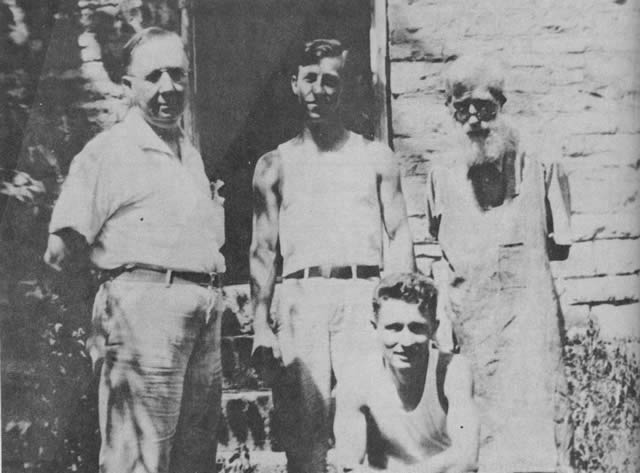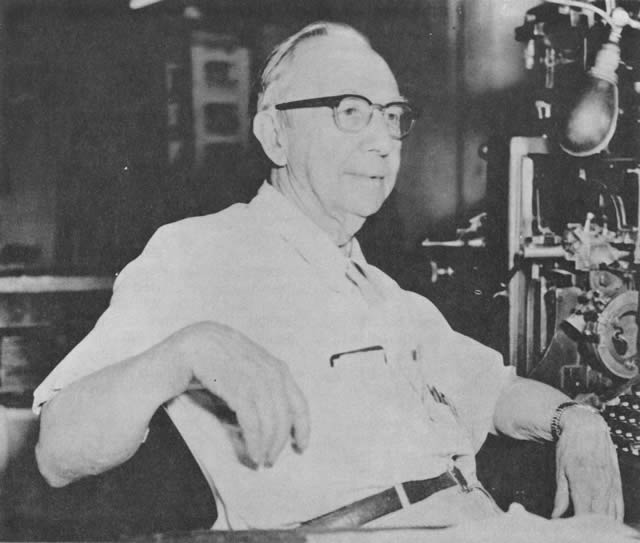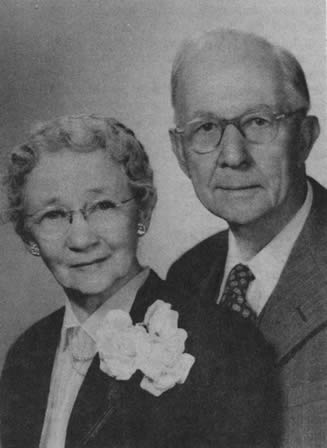Volume 2, Number 5 - Fall 1965
Pathways of the Press
From Elmo Ingenthron Manuscript

Newspaper staff in old Forsyth, Missouri, Summer 1935. Left to right: (standing) W. E. Freeland;
John Siv, now a printer with the St. Louis Post-Dispatch; printer (not identified); bottom row: Russ Howe, of St. Louis, Missouri.
- Photo courtesy of Russ How, St. Louis, Missouri
The establishment of towns and villages in the upper White River valley as elsewhere on the American frontier, soon brought newspaper enterprises. The equipment needed to start a newspaper then consisted of a simple outlay compared to modern times. It only took a quantity of metal type, a simple press, ink and paper. The entire operation was done with hand labor. The type was set by hand, the inking process was done by hand and the paper was placed on the press and retrieved from it by hand. Even the press was activated by manual labor. The entire printing equipment could be moved from place to place as conveniently as household furniture.
The first weekly newspaper printed in the upper reaches of the White River watershed was the Ozark Standard and the Ozark Eagle published at Springfield, Missouri in 1838. In May 1844 the Springfield Advertiser, a successor to the Standard and the Eagle, was published by Warren H. Graves. It was a four-page paper with six columns to the page and was Democratic in politics. Its early circulation consisted of some 400 subscribers. It grew and continued until the outbreak of the Rebellion.
[2]
In 1846 John P. Campbell began publication of the Texas Democrat at Springfield. It was a weekly newspaper edited by E. D. McKinney, a son-in-law of Mr. Campbell. The Democrat ceased publication in 1848.
Another pre-Civil War newspaper was started at Ozark in 1860. It was called the Ozark Banner and was published by J. C. Shook, a Confederate sympathizer. It ceased publication with the outbreak of the Rebellion and was destroyed by Union sympathizers.
Following the end of the great conflict a number of newspapers made their appearance in the various towns and villages of the upper White River valley. In 1866-67 the Missouri Patriot, the Southwest Union Press, the Journal and the Leader & Press began publication in Springfield. Within a few years numerous other newspapers were in the field.
In 1869 the Monitor and the Leader became established newspapers at Ozark in Christian County. They are thought to have been combined into one publication about 1874. The Christian County Herald made its appearance in Ozark in 1872 and the Republican Farmer in 1876.
According to Rowell’s Newspaper Directory, Stone County’s first newspaper was the Galena Times which was printed from 1878 to 1887. The issues of the Greenback Party ushered in the Stone County Signal, a supporter of the Greenback cause. It was printed during the years of 1880-1881. 1884 saw the beginning of the Stone County News Oracle. The Home Advocate started its weekly publication in 1889. The Advocate was discontinued in 1891.
In Ozark County the Gazette-Tribune made its appearance in 1876. It was followed by the New Era in 1880. The Ozark County News and the Ozark County Times were established in 1882. The News later joined the Times to become Ozark County’s dominant newspaper.
According to Pettengill the Douglas County Leader was established in Ava in 1877. In 1879 the Ava Times appeared followed by the Douglas County Public Record in 1885 and the Douglas County Herald in 1887. The Herald is today Douglas County’s oldest established business.
In 1869 Thomas Newman started the Boone County Advocate in the new town of Harrison, Arkansas. In 1874 the Carroll County Farmer made its appearance in Carroll County, Arkansas. It was printed in Bentonville and distributed in Carroll County. The Carroll County Boulder, published by W. S. Tilton and E. R. Marvin at Carroll-ton, started publication about the same time the Farmer appeared. The Boulder experienced a good circulation with local correspondents in most of the townships of the county.
Taney County, like her adjacent counties in Missouri and Arkansas experienced the rise and fall of many weekly newspapers in the last three decades of the 18th century and the early 19th century. This was a period of many progressive changes and many issues were before the people. There were many causes to advance and many evils to subdue. The newspaper served as the best means to promote or defend whatever the causes were.
In order to better appreciate the problems and challenges of the newspaper enterprises in the upper White River region, let us examine in more detail the history of newspapers in Taney County.
The Forsyth Banner was one of the first newspapers to appear in Taney County. It is believed to have started publication soon after the Civil War by Dr. William R. Howard. The name of the Banner was changed to The Southwest Pioneer about 1868-1870. The Pioneer was a four-page publication about 12 by 15 inches in size, according to William E. Freeland who once saw a copy of it. The Pioneer was sold to J. J. Brown in the early 1870’s.
In 1874 the Pioneer Farmer, successor to the Southwest Pioneer, was being published by Brown and Dipley at Forsyth. It advertised itself as the best family and agricultural journal published in southwest Missouri. It had a subscription rate of one dollar per year and claimed to be devoted to the interest of the farmer and the laboring classes. It ceased publication in 1878.
Another early newspaper about which little is known was the Forsyth Times. According to Rowell’s directory it was printed at Forsyth in 1875-76.
About the time the Pioneer Farmer discontinued publication the White River Herald made its appearance at Forsyth and is believed to have been the successor to the Farmer. It was listed in Rowell and Ayers directories as having been printed in 1879-80.
Two newspapers came into circulation about the time the White River Herald ceased publication. They were the Taney Enterprise and The Farm and Home. Both began publication in 1881. The Enterprise was published until 1883 and The Farm and Home until 1885.
[3]

No article concerning the press of the white River Valley would be complete without a picture and special note concerning W. E. Freeland and Minnie Freeland. Someday this Quarterly Magazine will carry a feature relating the facts of the record of Senator Freeland, the dean of newspaper men of the area. But really, Mrs. Minnie Freeland was the first Freeland to publish the Taney County Republican. When Mr. and Mrs. Freeland bought the paper, the U. S. Government refused to release Mr. Freeland from his job with the Indian Agency. So Mrs. Freeland, a real 'better half-part,' with the help of Fred R. Moran, Sr., and a man to turn the old hand press, carried on, telling the news of Taney County. Readers of the paper are yet today delighted when the newspaper carries one of Mrs. Freeland's stories about some simple homey event.
The Farm and Home was reportedly printed in one room of the Taney County court house and was destroyed by fire when the court house burned in December 1885. It was the only newspaper being printed in the county at that time.
For about a year after the court house burned Taney County was without a newspaper. Then in November 1886 t h e Taney County News was established. It was printed by B. W. Young and R.W. DeLong. It continued publication until August 27, 1891.
On November 27, 1887 the Taney County Times appeared. It was printed at Kissee Mills by S. C. Kissee. The Times was an outstanding newspaper for that time, according to W. E. Freeland, a good authority on local newspapers.
[4]
Mr. Kissee made his own wooden cuts for the pictures, among which was one of Jim Miles charged with the shooting of Sheriff G. E. Branson at the Kirbyville picnic in 1889. Another was of John L. Sullivan and Jake Kilrain who fought for the heavy-weight world championship on July 8, 1889.
The Taney County Times, like most newspapers of that period, solicited job printing. This ad, taken from the March 5, 1891 issue, gives an insight into the needs of the Times:
FOR HORSEOGRAPHS AND JACOTYPES
All sorts of Jack Bill Literature,
Apply at the Times Office.
In 1890 the Taney County Times was purchased from the Kissee family and moved to Taney City where its influence was used to promote the removal of the county seat from Forsyth to Taney City. After experiencing failure in the removal venture, the stockholders of the Times voted to move it to Forsyth. Instead, however, the equipment is believed to have been hauled to the Conner Bend of White River and stored in a barn for a time.
Two weekly newspapers about which little is known was the Mountaineer and Missouri Tidings. According to Rowell’s directory the Mountaineer was published at Brown Branch in 1891-92. Both Rowell and Ayers listed Missouri Tidings as having been printed at Bradleyville from 1890-93.
The Taney County Star, published by James O. Carroll at Taney City from 1891 to 1894, was moved to Forsyth. In November 1895, B. B. Price and S. J. Williams purchased the Star from Mr. Carroll. The new owners discontinued the Star and began publication of the Taney County Republican. W. H. Price was listed as its first editor.
In 1893 the White River Herald made its second appearance. Ben McPherson, with the use of the Times equipment, is believed to have reestablished the Herald. He was listed as editor with Andrew Brown, J. C. L. McKnight and J. G. Siler as associate editors. The next year the Herald obtained the county printing. It is believed to have discontinued publication soon after, being joined to the Taney County Republican. With the union of the Times, the News and the Herald, the Taney County Republican was destined to become the leading newspaper of the county for more than seventy years.
Another interesting newspaper of the 1890’s was the Taney County Sentinel. It is listed by Rowell and Ayers as having been published from 1890 to 1900. This weekly newspaper was apparently started at Taney City (Taneyville) in 1890. It was being published at Goodloe by W. R. Adams in the mid 1890’s. Its last mailing address was given as Bradleyville in 1899-1900.

Mr. and Mrs. W. E. Freeland, former editors and publishers of the white River Leader and the Taney County Republican, now counselor and editor emeritus of the Taney County Republican.
In 1897 the Taney County Star made its second appearance. It was re-established at Taney City by O. A. Truman. There were apparently two newspapers printed at the Star shop. In addition to the Star there appeared the Silver Democrat. This was during the time that free coinage of silver was a major national issue in politics and the silverites had a strong following in Taney County. Apparently the Silver Democrat became the Taney County Democrat which was printed from 1897 to 1901.
In May 1901 a newspaper known as the Taney County Leader was established. It was printed until November 28th of that year after which it either discontinued publication or united with the Taney County Republican, the dominant newspaper of the county.
In the spring of 1901 John Q. Adams and his brother, W. R. Adams, began publication of the
[5]
White River Press at Protem. The Press was a five column, four-page, neatly printed paper. In the autumn of 1901, W. R. Adams assumed the responsibilities of the paper and moved it to his home at Goodloe where he continued to publish it for a time.
It is interesting to note the fads that developed in the local newspapers around the turn of the century. The following captions and pen names from various rural correspondents appeared in the Taney County Republican in 1903-04:
COMMUNITY |
CAPTION |
PEN NAME |
Bluff |
Bits from Bluff |
A. Democrat |
Branson |
Branson Brevities |
Novous Homo |
Day |
Day Doings |
Nothing Else to Do |
Pedrow |
Picked up at Pedrow |
Nella |
Swan |
Swan Sayings |
Agricola |
Ameera |
Ameera Amenities |
Amateur |
Irma |
Images from Irma |
Country Lassie |
Victor |
Victor Verities |
Captain Jack |
Flag |
Flutters from Flag |
Uncle Wash |
Kissee Mills |
Kissee Mills Music |
Slim Jim |
Garber |
Garber Gleanings |
Jack |
Antioch |
Acted at Antioch |
Fritz |
Cedar Valley |
Cedar Valley Views |
Plowboy |
Lone Star |
Twinkles from Lone Star |
Bonny Jean |
Pine Top |
Pinetop Boughs |
Occasional |
Windy |
Wafted from Windy |
Will o’ the Wisp |
Osaka |
Osaka Observations |
Little Willie |
Dit |
Doings at Dit |
Snake Eye |
Protem |
Points from Protem |
Ram’s Horn |
Branson’s first newspaper was the Lucia Locomotive which made its appearance with the coming of the White River - Iron Mountain railroad in 1903. Branson was often called Lucia at that time. Higdon Melton was the publisher of the Locomotive which was printed at Forsyth. It claimed to specialize in railroad news and had a subscription rate of $1.50 per year. Its existence appears to have been of short duration.
The Branson Echo was first printed on November 17, 1905 and continued publication until November 29, 1909. In 1907 the county court gave the county printing to the Echo for 30 cents per square, the Echo having out bid the Republican at Forsyth.
The Taney County Democrat appeared in the county for the second time on February 10, 1910. This paper was published at Branson while the former Democrat was printed at Taney City, a decade earlier. The new Democrat was destined for even a shorter life than the former one with its last issue dated November 17, 1910.
About the time the Branson Echo ceased publication the Branson Sentinel appeared. It is believed to have been the successor to the Echo or the Democrat or both. The Sentinel was printed between 1910 and 1915. It terminated in a lawsuit between Ester Reichenback, the editor and the printer, and Frank Hoskins, the owner. It was a partnership arrangement whereby Reichenback, a Democrat would run the paper and obtain the state printing from the Democratic state administration. The parties were to divide the money received from the state which resulted in a lawsuit and the termination of the newspaper.
Branson’s next newspaper was the White River Leader first published on May 9, 1913 with Quincy L. Nace as editor. The Leader experienced several changes in ownership and irregular publications for short periods of time. Associated with the Leader were Mr. and Mrs. E. J. Hoenschel, W. L.
[6]
Laughton, C. L. McCauley, W. S. Luce, Charles E. Lee, Rockwell Fletcher, Mr. and Mrs. F. O. Runyon, Mr. and Mrs. W. E. Freeland and daughters, Frieda and Maude, Lloyd and Mary Hursh, Don Hecke, and Mr. and Mrs. Lee Beasley. The Leader still finds a wide acceptance and is presently published by the Tri-Lakes Press.
In 1920 The Menace began publication with Billy Parker as Editor. It was an anti-Catholic publication and even though its circulation was among predominately Protestant readers its radical nature doomed it to failure.
In September 1956 the Branson Beacon was established. It was printed by the S & S Press, which consisted of a partnership arrangement of Leon Farrell, Leon Atkinson and Steve Miller. In November 1960, Mr. and Mrs. Leon Farrell obtained full ownership of the Beacon which had become an outstanding weekly newspaper with a well-equipped printing shop.
Following the growth and development of Hollister on the new railroad, the Hollister News began publication in 1911 and is believed to have discontinued publication December 26, 1918. It is believed to have been re-established for a short time in 1927-28 as it was listed in Ayers directory for those years. After its discontinuance, the files of the Hollister News became the property of the Taney County Republican.
The White River Bulletin, a weekly publication, was started in 1908 by W. H. Johnson at Hollister. It was devoted to the promotion of Hollister and is believed to have ceased publication in late 1909.
Taney County has had at least three monthly publications. They were the Bull Shoals Gazette, Ozark Mountaineer and Rural Ozarks. Rural Ozarks was published by J. D. McManince and E. J. Hoenshel, about the end of World War I. The Bull Shoals Gazette was published by Frank Strickling from 1951 to 1954. The Ozark Mountaineer, a unique Ozark wide Monthly Periodical, is published by the Ozark Commonwealth, Roscoe Stewart, Chairman. The Mountaineer is an outstanding publication with a large editorial staff of experts in their field. It has done much to preserve the heritage of the hills and promote the future growth and development of the area. The Mountaineer began publication March 1952.
[15]
This volume: Next Article | Table of Contents | Other Issues
Other Volumes | Keyword Search | White River Valley Quarterly Home | Local History Home
Copyright © White River Valley Historical Quarterly

